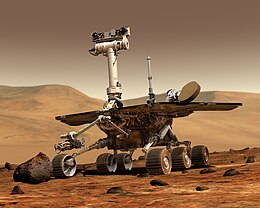
Back Opportunity AN أبورتيونيتي Arabic Opportunity AST Opportunity (марсаход) Byelorussian Опъртюнити (марсоход) Bulgarian Opportunity BS Opportunity Catalan ئاپرتوونتی CKB Opportunity Czech Opportunity Danish
 An artist's portrayal of Opportunity operating on the surface of Mars | |
| Mission type | Mars rover |
|---|---|
| Operator | NASA |
| COSPAR ID | 2003-032A |
| SATCAT no. | 27849 |
| Website | marsrovers |
| Mission duration | Planned: 90 sols (92.5 Earth days) Actual: 5,352 sols (8 Mars years), 5,498 days (15 Earth years) |
| Spacecraft properties | |
| Spacecraft type | Rover |
| Launch mass | Total: 1,063 kg
|
| Start of mission | |
| Launch date | July 8, 2003, 03:18 UTC[2][1] |
| Rocket | Delta II Heavy[1][3][4] |
| Launch site | Cape Canaveral SLC-17B |
| Contractor | Boeing |
| End of mission | |
| Declared | February 13, 2019[5] |
| Last contact | June 10, 2018[5] |
| Mars rover | |
| Landing date | January 25, 2004,[2] 05:05 UTC SCET MSD 46236 14:35 AMT |
| Landing site | 1°56′46″S 354°28′24″E / 1.9462°S 354.4734°E[6] Eagle, Meridiani Planum |
| Distance driven | 45.16 km (28.06 mi)[7] |
 The launch patch for Opportunity, featuring Duck Dodgers (Daffy Duck) NASA Mars rovers | |
Opportunity, also known as MER-B (Mars Exploration Rover – B) or MER-1, is a robotic rover that was active on Mars from 2004 until 2018.[2] Opportunity was operational on Mars for 5111 sols (14 years, 138 days on Earth). Launched on July 7, 2003, as part of NASA's Mars Exploration Rover program, it landed in Meridiani Planum on January 25, 2004, three weeks after its twin, Spirit (MER-A), touched down on the other side of the planet.[8] With a planned 90-sol duration of activity (slightly less than 92.5 Earth days), Spirit functioned until it got stuck in 2009 and ceased communications in 2010, while Opportunity was able to stay operational for 5111 sols after landing, maintaining its power and key systems through continual recharging of its batteries using solar power, and hibernating during events such as dust storms to save power. This careful operation allowed Opportunity to operate for 57 times its designed lifespan, exceeding the initial plan by 14 years, 47 days (in Earth time). By June 10, 2018, when it last contacted NASA,[9][10] the rover had traveled a distance of 45.16 kilometers (28.06 miles).[7]
Mission highlights included the initial 90-sol mission, finding meteorites such as Heat Shield Rock (Meridiani Planum meteorite), and over two years of exploring and studying Victoria crater. The rover survived moderate dust storms and in 2011 reached Endeavour crater, which has been considered as a "second landing site."[11] The Opportunity mission is considered one of NASA's most successful ventures.[12]
Due to the planetary 2018 dust storm on Mars, Opportunity ceased communications on June 10 and entered hibernation on June 12, 2018. It was hoped it would reboot once the weather cleared,[13] but it did not, suggesting either a catastrophic failure or that a layer of dust had covered its solar panels. NASA hoped to re-establish contact with the rover, citing a recurring windy period which was forecast for November 2018 to January 2019, that could potentially clean off its solar panels.[14] On February 13, 2019, NASA officials declared that the Opportunity mission was complete, after the spacecraft had failed to respond to over 1,000 signals sent since August 2018.[15]
- ^ a b c Cite error: The named reference
LaunchDetailswas invoked but never defined (see the help page). - ^ a b c Nelson, Jon. "Mars Exploration Rover – Opportunity". NASA. Archived from the original on January 24, 2014. Retrieved February 2, 2014.
- ^ Cite error: The named reference
nasawas invoked but never defined (see the help page). - ^ Cite error: The named reference
Jonathan's Space Report No. 504was invoked but never defined (see the help page). - ^ a b Agle, D.C.; Brown, Dwayne; Wendel, JoAnna (February 13, 2019). "NASA's Opportunity Rover Mission on Mars Comes to End". NASA. Retrieved February 14, 2019.
- ^ Staff. "Mapping the Mars Roversnd' Landing Sites". Esri. Archived from the original on May 4, 2014. Retrieved May 4, 2014.
- ^ a b "Mars Exploration Rover Mission: All Opportunity Updates". nasa.gov. Archived from the original on August 30, 2015. Retrieved September 18, 2018.
- ^ Cite error: The named reference
januarywas invoked but never defined (see the help page). - ^ Malik, T. (June 21, 2018). "Mars Dust Storm 2018: How It Grew & What It Means for the Opportunity Rover". space.com. Future.plc. Retrieved February 14, 2019.
- ^ Rayl, A.J.S. (August 1, 2018). "The Mars Exploration Rovers Update: Dust Storm Wanes, Opportunity Sleeps, Team Prepares Recovery Strategy". planetary.org. Planetary Society. Retrieved February 14, 2019.
- ^ Cite error: The named reference
wustlwas invoked but never defined (see the help page). - ^ Amos, Jonathan (February 13, 2019). "Nasa calls time on silent Opportunity Mars rover". BBC. Retrieved February 14, 2019.
- ^ Greicius, Tony (September 24, 2018). "Opportunity Emerges in a Dusty Picture". NASA. Archived from the original on October 15, 2018. Retrieved November 30, 2018.
- ^ Greicius, Tony (October 29, 2018). "Update on Opportunity Rover Recovery Efforts". NASA. Archived from the original on November 3, 2018. Retrieved February 23, 2022.
- ^ "NASA's Opportunity Rover Mission on Mars Comes to End". NASA. February 13, 2019. Retrieved February 13, 2019.